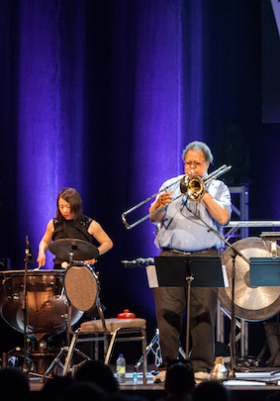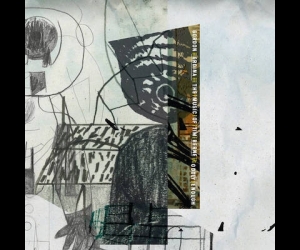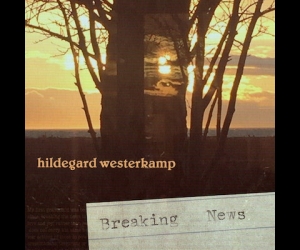The Festival International Musique Actuelle Victoriaville (FIMAV) arrives with the late, brief spring of Quebec’s central region, an energizing jolt between winter and summer that sees the flowering of older vines and new life bursting through the earth. This year’s instalment of FIMAV did what it has done very well for many years: present challenging music that can find a substantial audience, while also testing the frontiers with little-known but significant musicians.
It’s unlikely that a group of microtonal tubaists will ever find an audience as large as that of Inuit throat singer Tanya Tagaq, but they’re both ardent explorers at the creative edges of music; it’s FIMAV’s great virtue that it makes a home for both, using the elastic concept of musique actuelle to range freely through genres. Events ranged from afternoon sound artists to late-night avant-rockers, with listeners creating their own paths through the festival’s nineteen performances. Composer-trombonist George Lewis once declared, “what I always wanted: music as a space for reflection on the human condition.” That’s a lofty goal and a rare event, but several groups were able to do it, whether working with or without a script, playing with associates they had either known for fifty years or had just encountered.
One such work was Friday night’s Saumon Bleu, a conduction by French musician Olivier Benoit, directing an ensemble that combined seven members of Montreal’s Supermusique with seven members of Rimouski’s Ggril, two of Quebec’s distinguished large improvising ensembles . It was a work of brilliant simplicity that began and ended with the quietest sizzle of scratched strings and softly blown reeds strongly suggesting human breath, ultimately crafting a space in which audience and band were one.
Tanya Tagaq
[profiled in Issue 118] provided another uniquely inspired improvised performance, a staggering seventy minutes in which she seemed to be performing constantly, a protean ritual in which conflict and resolution arose in the very array of voices she tapped into, from low-pitched gutturals to high-pitched whispers and sighs, sometimes plumbing extraordinary techniques of resonance to produce the two sounds together. Christine Duncan
[profiled in Issue 124] led a group of local singers in a spontaneously conducted Element Choir that provided a kind of empathetic Greek chorus, lending ever-greater scale to Tagaq’s magnificent and elemental psychodrama.
George Lewis’s accomplishments range from scholarly writing to interactive computer music, but there’s a singular focus to his work, made abundantly clear in Calder, a work that treats the sculptor’s mobiles as musical premises. The all-acoustic performance set Lewis and his trombone on a stage covered with percussion instruments. Thurman Barker, Eli Fountain, Aiyun Huang, and Tyshawn Sorey worked purposefully, moving about the stage and through the movements of Lewis’ composition, creating tranquil and dynamic moments in turn on various drums and metal percussion. Each moment assumed its place in an extended meditation on space and sound. In its quietest moments, Barker sounded the cymbals by rapidly waving his hands in the air. [For more on Lewis and Calder see Kurt Gottschalk's piece from Issue 124.]
2016 marks the fiftieth anniversary of Musica Elettronica Viva (MEV) and its three founders, Alvin Curran, Richard Teitelbaum, and Frederic Rzewski, marked the event with a singular improvisation that was an inquiry into history, a profound lament that stretched to include Rzewski’s oracular piano and his moving stories of European horrors of a century ago, Teitelbaum’s fidelity to harshly honest electronic sound, and Curran’s shofar, using the ancient Jewish ceremonial horn fashioned from a ram’s horn near the piece’s conclusion. If MEV is famous for adapting technology to live performance, their work endures for the richness of its concentrated humanity.
Each of FIMAV’s strongest performers made new space and created new levels of resonance, whether literally and physically or culturally and psychologically. Perhaps none did so more than Microtub, with Robin Hayward, Peder Simonsen, and Martin Taxt playing three of the world’s four microtonal tubas. Together they explored compositions that created tremendous temporal space using long tones, then found in their rare instruments very specific, previously unheard pitch intervals, distances that took close listening into new territory.
If those performers were the highlights for this listener, there was much to like in the three linked concerts devoted to John Zorn’s Bagatelles, brief compositions tailor-made for improvised elaboration. It was one of Zorn’s most elaborate presentations, with twenty musicians arranged in nine ensembles extending over five hours. The units brought very different approaches to the works, emphasizing the clash of genres and the collage and juxtaposition that are central to Zorn’s work, his megaconcert an analogue to FIMAV’s own defining aesthetic of difference and inclusion.



